User’s Guide
Sevice Locater
ADDRESS MPIO BV, Planetenweg 11-41, unit 23A, 2132 HN Hoofddorp, The Netherlands
E-MAIL jwseo@mpio.com (Swizerland, France, Benelux (Belgium, Netherlands, Luxembourg))
paperbag@mpio.com (germany, Portugal, Eastern Europe)
tony@mpio.com (United Kingdom, Spain, Scandinavia(Norway, Sweden, Denmark)
daizina@mpio.com (Others Europe)
TEL 001-31-23-557-7889
FAX 001-31-23-562-5752
HOMEPAGE http://www.mpio.com
C/N: 408-001-0166
This document is intended for informational and instructional purposes only.
mpio reserves the right to make changes in the specifications
and other information contained in this document without prior notification.
mpio disclaims any obligation to update information contained herein.
�
2
♦ PD100 User’s Guide ♦
Thank you for purchasing MPIO PD100.
This guide has been designed to provide you with complete product
knowledge including important safety and operating instructions.
Please read this user’s guide carefully before using your MPIO
PD100.
MPIO believes that you will be pleased with the PD100’s advanced
capabilities.
At MPIO, we always put our best effort into providing you with the
best products to deliver a level of customer service that exceeds your
expectations.
MPIO
3
Important safety Instructions:
• All the safety and operating instructions should be read before the product is
operated.
• All information, artwork, text, video, audio, pictures, software, and other
intellectual property are protected by copyright and international laws. You may
not reproduce, distribute, publicly perform, publicly display, modify or create
derivative works from the intellectual property, unless authorized by the
appropriate copyright owner(s). MPIO does not encourage any of our customers
to use copyrighted intellectual property illegally by using this product.
• Read these instructions carefully so you will understand them, enabling the safe
operation of your PD100. MPIO is not responsible for any damage due to the
installation, repairs, or adjustments of customer controls in the home; nor for any
misuse, abuse, negligence, acts of God, or other causes beyond the control of
MPIO.
• Do not use the PD100 for other any other purposes not mentioned in this guide.
• To avoid injury, be careful when handling the product box, the ‘User’s Guide’,
and component parts. The CD, containing the ‘User’s Guide’, should be retained
for future reference.
• Do not subject the product to excessive force or impact. It can seriously
damage or disable your product.
• The products should be kept away from high temperatures, high humidity,
extremes of motion, and strong magnetic fields.
• Keep away from excessive moisture and do not immerse the product in water.
�
• Do not attempt to service, disassemble, or modify the player yourself. This will
void your warranty. You must back up the drive. MPIO is not responsible for
lost data due to malfunction, wrongful operation, or user repairs on the player.
Please keep the instructions in mind when you are operating the player.
4
• Avoid using headphones/earphones for continuous listening at high volumes. If
you experience a ringing in your ears, stop using it or reduce the volume.
• Grasp the plugs (not the cables) when connecting or disconnecting the
earphones. Pulling on the cables may cause a bad connection.
• Ensure that the USB cable is correctly connected to your computer and the
PD100. Connecting in the wrong direction may cause malfunction and/or
damage to your computer and the PD100.
• Do not leave the USB cable connected to your PC for long periods of time.
• Do not subject the connections to excessive force or impact.
• Do not leave the USB cable connected to a PC or external equipment for long
periods.
• Keep the USB cable connections clean at all times.
• Wipe with a soft cloth or towel if the player is dirty. Do not use any chemicals to
clean the player.
Table of Contents
Chapter 1: About MPIO PD100
1. Overview ............................................................................................. 7
2. Specifications ...................................................................................... 9
3. Computer system requirements ........................................................ 10
4. References ....................................................................................... 11
5. Accessories ....................................................................................... 11
6. Views, Buttons and Operations ........................................................ 12
7. LCD Display ...................................................................................... 14
5
Chapter 2: PD100 Setting up and Basic Operations
1. Using AC Power Adaptor ................................................................. 20
2. Charging Battery ............................................................................... 20
3. Installing USB Device Driver ............................................................. 23
4. Power ON/OFF ................................................................................. 24
5. Volume Control ................................................................................. 24
6. Entering and exiting folders .............................................................. 25
7. Audio Playback/Stop ......................................................................... 25
8. Downloading Music and Data files .................................................... 27
9. Disconnecting the PD100 from your PC ........................................... 28
10. Changing modes between: MUSIC/RECORD/FM RADIO/
ENCODING/SETTINGS ................................................................. 28
11. Using the Lock and Unlock functions .............................................. 30
�
6
Chapter 3: Using all functions of MPIO PD100
1. MUSIC Mode .................................................................................... 31
1) Button Operation .......................................................................... 31
2) Operation of Functions ................................................................. 32
2. VOICE RECORDING Mode .............................................................. 42
1) Button Operation .......................................................................... 42
2) Operation of Functions ................................................................. 43
3. FM RADIO Mode .............................................................................. 48
1) Button Operation .......................................................................... 48
2) Operation of Functions ................................................................. 49
4. ENCODING Mode ............................................................................ 61
1) Button Operation .......................................................................... 61
2) Operation of Functions ................................................................. 62
5. DAB Mode ....................................................................................... 67
1) Button Operation .......................................................................... 67
2) Operation of Functions ................................................................. 68
6. SETTINGS Mode .............................................................................. 82
1) Button Operation .......................................................................... 82
2) Operation of Functions ................................................................. 83
Additional Information ........................................................................ 95
1) Connecting your MPIO PD100 to the host PC .................................. 95
2) Firmware Upgrade ............................................................................. 95
3) WMP(Windows Media Player) Plug-In ............................................. 96
1. About MPIO PD100
1. Overview
1) Hand-held Personal Player
Personal type of convergence player for DAB/FM Radio/MP3(WMA).
2) DAB Radio
Simple navigation DAB Radio with 8 line big LCD screen and Band III
(174 – 250 MHz)
3) USB Mass Storage Function
Data files can be uploaded and downloaded without a separate manager program
because the PD100 is detected as a portable storage device when your MPIO
PD100 is connected to the host PC.
4) No one can make better product!
The MPIO PD100 is made for real MP3 Player fanatics.
PD100 also supports Standard and Preset EQ as well as five band EQ which can
be set by the user.
5) Multi-Codec Player
Supports MP3, WMA, and ASF formats as a multi-Codec player.
6) FM Tuner Function
The Built-in FM Tuner can scan channels automatically and has station memory
functions that make it easy for you to enjoy listening to local FM radio broadcast.
The PD100 can also record FM radio broadcasts while you are listening.
7
1
.
A
b
o
u
t
I
M
P
O
P
D
1
0
0
�
Direct recording DAB while listening channel.
Your player creates an encoding file from an external player without using a PC.
7) Direct Recording (Encoding) Function
8) Easy to use Graphic User Interface
MPIO made every effort to supply you a convenient, easy-to-use GUI menu.
PD100 provides a convenient, graphics-based menu and easy access at a
glance.
9) Navigation
The easy navigation with tree configuration makes it easy to search for and
record any song.
10) Voice Recording Function
PD100 performs various recording functions that support MP3 recording and
microphone recording. Recording quality controls and Monitor functions provide
an excellent voice recorder.
11) Upgrade Firmware
MPIO will put their best efforts into providing you with the best and latest features
through Firmware Upgrades.
MPIO comes closer to you, their customer, with the new PD100.
8
0
0
1
D
P
O
P
M
I
t
u
o
b
A
.
1
2. Specifications
Model
DAB System
Multiple Audio Codec
Format Support
Built-in Memory
LCD Display
Language Support
UI Menu Language
File Transfer Speed
Headphone Output
Signal to Noise Ratio
Audio Frequency Range
Battery
Continuous Playback Hours
FM Frequency Range
FM Output Power
FM Signal to Noise Ratio
Dimensions/Weight
Operating Temperature
MPIO PD100
Eureka 147 Standard
Band III (174 – 250 MHz)
MP3(8 ~ 320kbps), WMA(5 ~ 192kbps), ASF
128MB, 256MB(option), 512MB(option)
Blue LED backlight, 8lines
29.43x24.31mm 4 gray graphic LCD
English
English
USB 1.1 (Full Speed)
12mW(R:6mW, L:6mW)
96dB
20Hz ~ 20KHz
Rechargeable Lithium ion Battery
Up to 46 hours with MP3
Up to 9 hours with DAB
Up to 40 hours with FM
76 ~ 108.0MHz
10mW(R:5mW, L:5mW)
45dB
84(H)x 60.6(W)x 19.7(D)mm / 106g
5°C ~ 40°C
9
1
.
A
b
o
u
t
I
M
P
O
P
D
1
0
0
�
4. References
• Actual formatted capacity may be less than the storage’s capacity marked on box
and user’s guide.
• Data transfer rate may vary depending on the computer systems.
• Playing time may vary depending on the usage, configuration and condition.
5. Accessories
3. Computer system requirements
1) Your PD100 player needs these minimal system requirements for your
computer.
10
0
0
1
D
P
O
P
M
I
t
u
o
b
A
.
1
•
IBM PC
- System: USB Interface (Rev 1.1) standard and CD-ROM Driver
- CPU: At least a Pentium 133MHz
- Memory: At least 64MB
- HDD Space: At least 20MB
- Supporting OS: Windows 98/2000/XP
• Macintosh
iMac/iBook, Powerbook, Powerbook G4
- System: USB Interface (Rev V1.1) standard and CD-ROM Driver
EX} Power Mac G3 (Blue & White)/G4/G4 Cube,
- Memory: At least 64MB
- HDD Space: At least 20MB
- Supporting OS: Mac OS 10.X & higher
Notes
• You must use the provided USB cable to connect with your PC because it
may not work with other extension cables.
• Please use an AC Adaptor for if you use an USB hub to connect with your PC
11
1
.
A
b
o
u
t
I
M
P
O
P
D
1
0
0
�
12
0
0
1
D
P
O
P
M
I
t
u
o
b
A
.
1
6. Views, Buttons and Operations
1) LCD Display
► Front View
(1) LCD: This is where the PD100’s user interface appears with file information
and menu selections.
- When the Jog key is in the center position, press the Key in to execute. This
calls up a sub menu, confirming selection status and recording function .
13
1
.
A
b
o
u
t
I
M
P
O
P
D
1
0
0
(5) Back Button: Press to go back to the previous display.
(6) Play/Pause Button: Press to turn power on/off and to play. During playback,
(7) Hold Key: To make the buttons inactive, slide down the hold key.
press to pause music.
► Top Side View
(8) Volume Key: Increases and decreases the volume level.
- (Press and hold the volume key down to increase volume rapidly.)
► Bottom Side view
(9) USB port:
- Use the cable to connect from the port to your computer.
(2) Insert the earphone plug here
(3) Reset
► Left Side View
► Right Side View
(4) Jog Key: This key provides song search capability and accesses the menu items.
- Use the Jog Key to search for music files or menu items you want to choose.
�
(10) Encoding port:
(11) AC Adaptor connector
- Attach the stereo cable here when you want to record files from a CD,
cassette player, or FM tuner.
14
0
0
1
D
P
O
P
M
I
t
u
o
b
A
.
1
7. LCD Display
1) DAB Mode
♦ 1 line
1. Indicates current received radio signal strength.
2. Displays the current playing title in DAB Mode.
3. Indicates battery level.
♦ 2 line
1. Displays the order of current playing channel.
2. Displays the number of all stations of the Channel List.
3. Type of music (Mono, Stereo, J-Stereo)
♦ 3 line
1. Displays the name of current playing channel.
♦ 5 line
1. Displays scrolling Digital Label(DLS)
♦ 6 line
1. Shows the status of current selected channel
♦ 7 line
1. Displays day, month, year and time
♦ 8 line
1. Displays label and frequency of current channel
2) MUSIC Mode
15
1
.
A
b
o
u
t
I
M
P
O
P
D
1
0
0
�
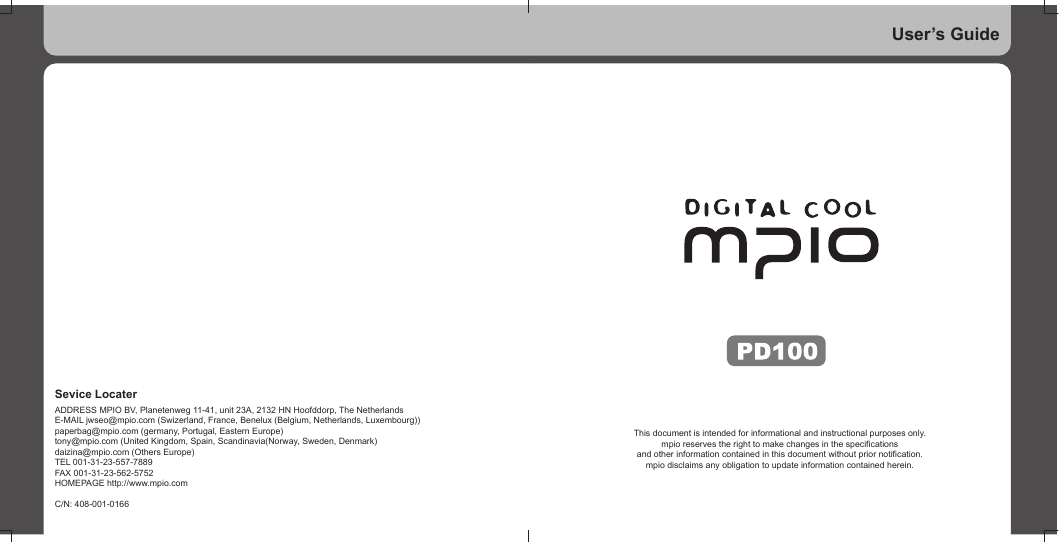

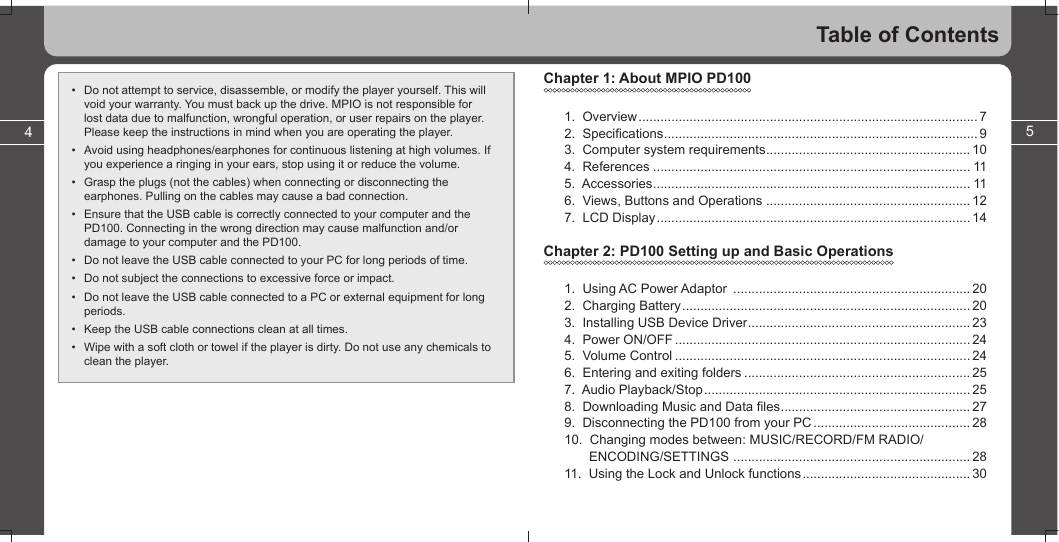

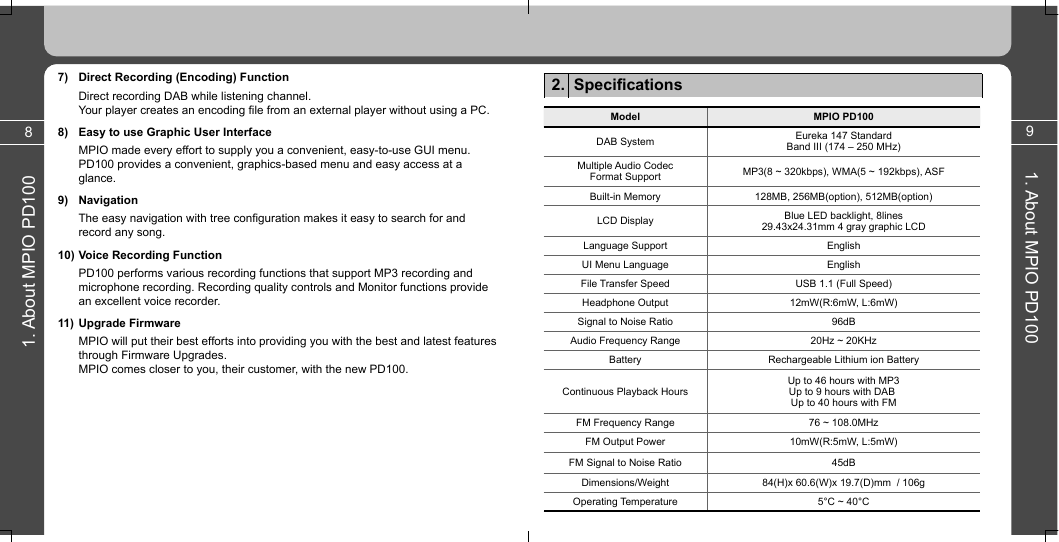
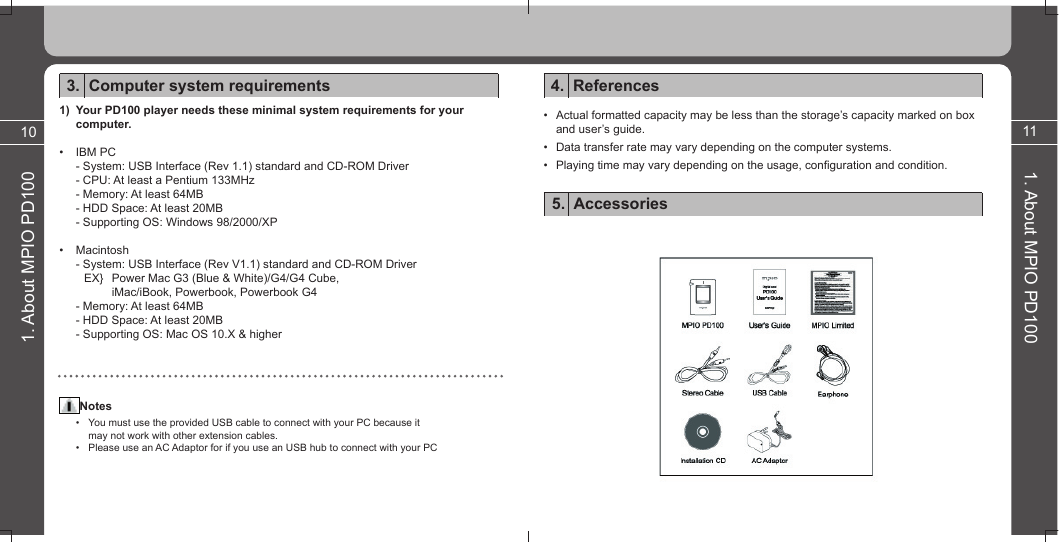
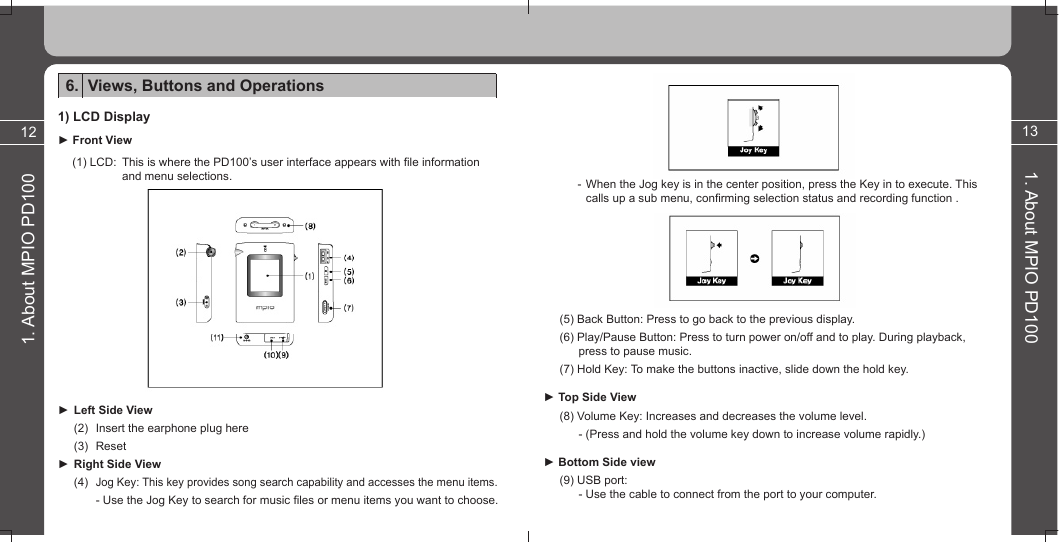
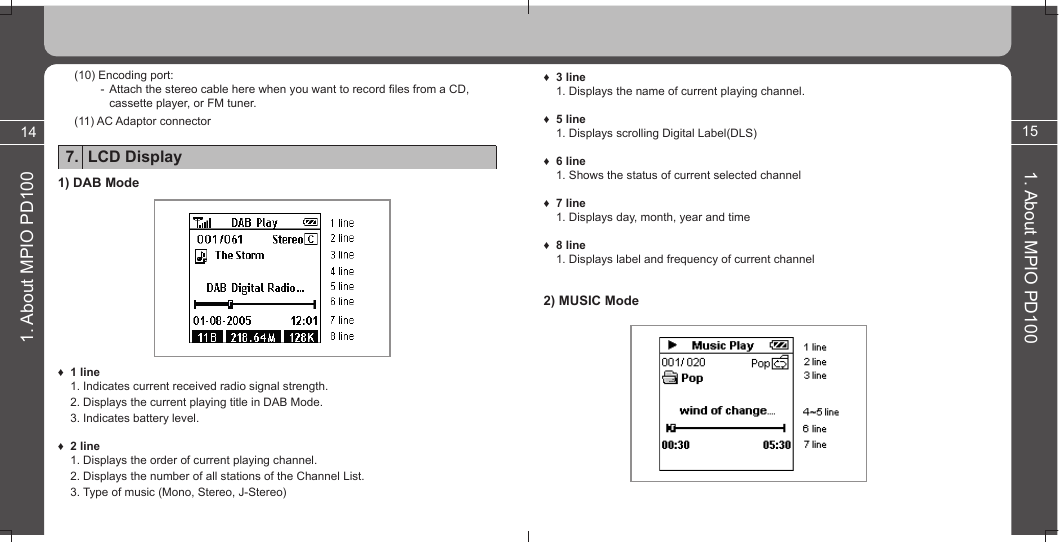








 2023年江西萍乡中考道德与法治真题及答案.doc
2023年江西萍乡中考道德与法治真题及答案.doc 2012年重庆南川中考生物真题及答案.doc
2012年重庆南川中考生物真题及答案.doc 2013年江西师范大学地理学综合及文艺理论基础考研真题.doc
2013年江西师范大学地理学综合及文艺理论基础考研真题.doc 2020年四川甘孜小升初语文真题及答案I卷.doc
2020年四川甘孜小升初语文真题及答案I卷.doc 2020年注册岩土工程师专业基础考试真题及答案.doc
2020年注册岩土工程师专业基础考试真题及答案.doc 2023-2024学年福建省厦门市九年级上学期数学月考试题及答案.doc
2023-2024学年福建省厦门市九年级上学期数学月考试题及答案.doc 2021-2022学年辽宁省沈阳市大东区九年级上学期语文期末试题及答案.doc
2021-2022学年辽宁省沈阳市大东区九年级上学期语文期末试题及答案.doc 2022-2023学年北京东城区初三第一学期物理期末试卷及答案.doc
2022-2023学年北京东城区初三第一学期物理期末试卷及答案.doc 2018上半年江西教师资格初中地理学科知识与教学能力真题及答案.doc
2018上半年江西教师资格初中地理学科知识与教学能力真题及答案.doc 2012年河北国家公务员申论考试真题及答案-省级.doc
2012年河北国家公务员申论考试真题及答案-省级.doc 2020-2021学年江苏省扬州市江都区邵樊片九年级上学期数学第一次质量检测试题及答案.doc
2020-2021学年江苏省扬州市江都区邵樊片九年级上学期数学第一次质量检测试题及答案.doc 2022下半年黑龙江教师资格证中学综合素质真题及答案.doc
2022下半年黑龙江教师资格证中学综合素质真题及答案.doc